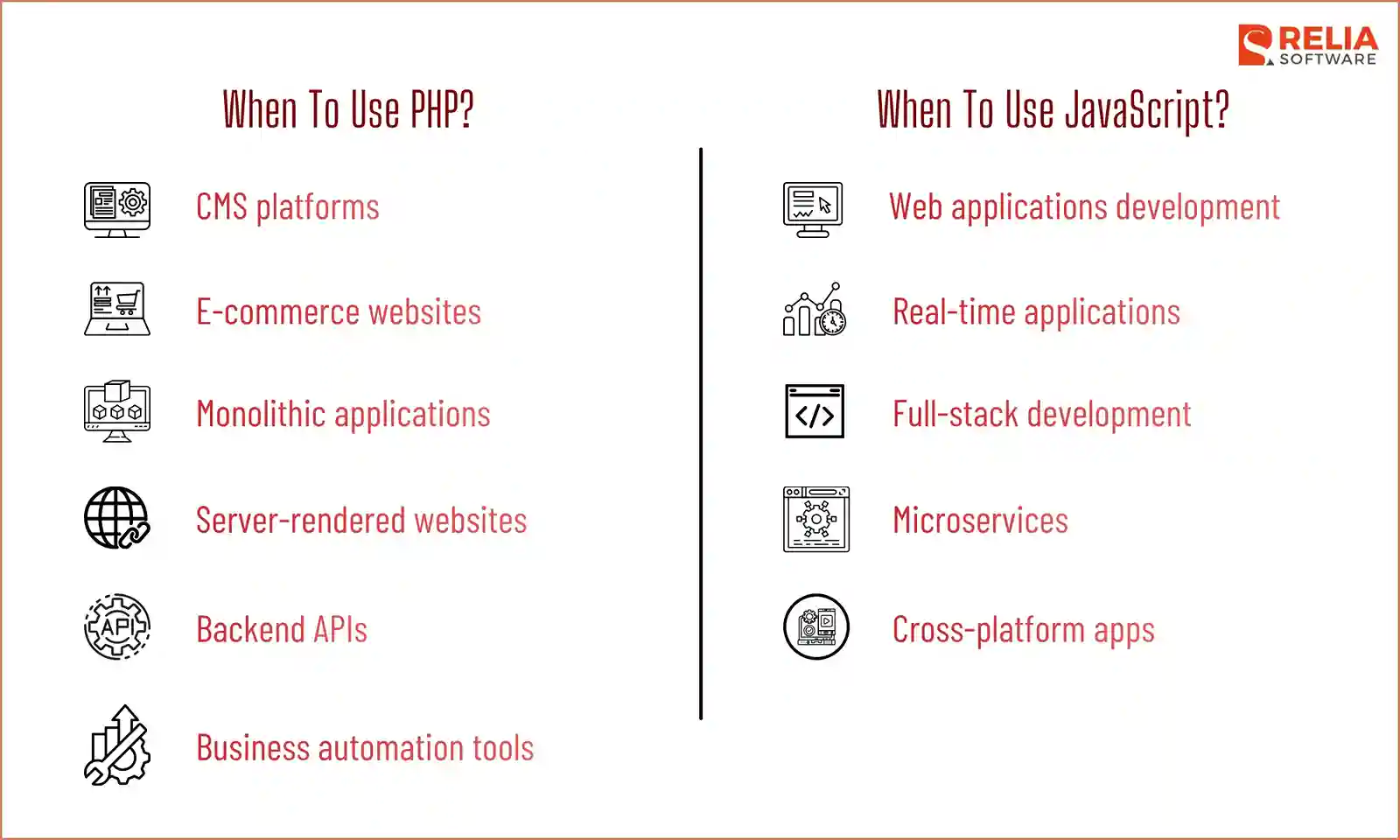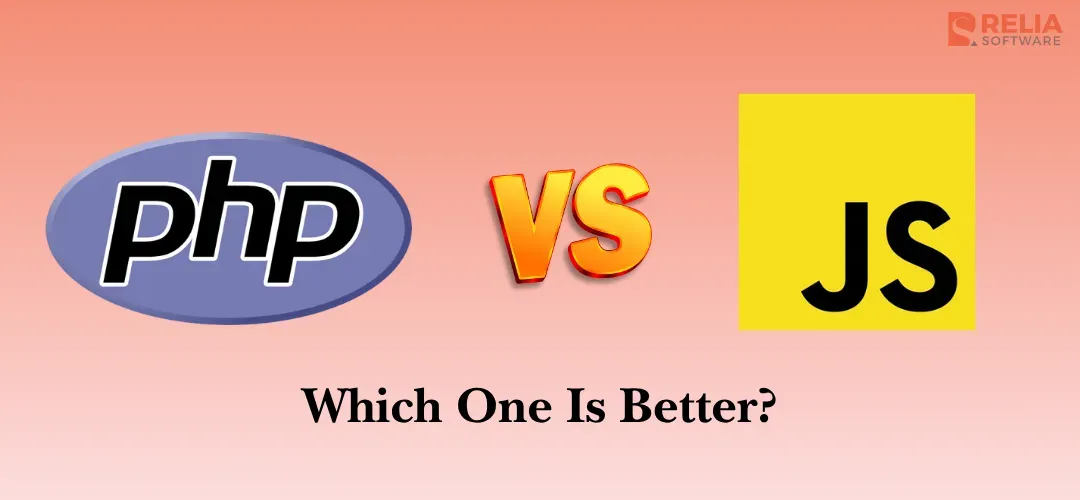Choosing between PHP vs JavaScript is still a common question for developers and teams starting new web projects. Today, JavaScript is used by about 66% of developers, while PHP sits at around 18.9%, showing how much more widely JavaScript is adopted in modern development. However, PHP is still recognized as a powerful server-side language for backend-focused projects. So, when to use each one?
In this article, we will give you a simple, updated breakdown of how the two languages differ in web development. For example, PHP is a natural server-side language, while JavaScript was previously a client-side language but is now used both client and server. Whether you’re building a classic website or a more dynamic web app, this clear comparison will help you decide which direction to take.
>> Read more: TypeScript vs JavaScript: Which Is Better For Your Project?
A Quick Overview of PHP and JavaScript
PHP
PHP is a popular open-source scripting language used mostly for backend or server tasks. It runs on the server and integrates well with classic website development, powering many content platforms and online shops. Although PHP doesn’t run in the browser, it prepares the page on the server before users see it.
JavaScript
JavaScript is also a scripting language, but used for client-side tasks such as making web pages responsive and interactive. However, later, with the arrival of Node.js, it also became a server-side option, allowing developers to use the same language for both frontend and backend work without switching between different tools.
>> Read more: A Comprehensive Guide of SOLID Principles in JavaScript
PHP vs JavaScript: Key Differences In Web Development
Aspects | PHP | JavaScript |
Primary Role | Backend development | Frontend + Backend (full-stack) |
Execution Model | Synchronous | Asynchronous |
Runtime Environment | Runs on the server | Runs in the browser and also on servers with Node.js |
Code Visibility | Code is hidden from users | Frontend JS is visible to users Backend (Node.js) is hidden like PHP |
Server-Side Use | Native backend language | Requires Node.js runtime |
Security Pattern | Frameworks offer strong built-ins | Powerful but depends heavily on packages |
Data Handling | Server-side data, queries, sessions, and authentication | Client-side actions, form behavior, UI changes Backend JS handles API data and real-time updates. |
HTML Output Flow | Generates HTML on the server and sends results to the browser | Updates and controls the page inside the browser |
Frameworks | Backend-focused (Laravel, Symfony) | Full-stack ecosystem (Node.js, Express, Next.js) |
Primary Role
PHP is a server-side language, so it is mainly used for server development. It handles tasks like reading data, processing forms, managing sessions, and sending the final page to the browser. Its job stays on the backend, and it focuses on the logic that happens before the user sees anything.
Meanwhile, JavaScript can work in both the frontend and backend, which makes it a full-stack web development language. In the browser, it controls page behavior and user interactions. With Node.js on the server, it can also build APIs, handle real-time features, and manage backend logic.
Execution Model
PHP uses a synchronous model, finishing one step before moving to the next. It is also multi-threaded, meaning the server can spin up separate threads to handle multiple requests at the same time. Each request still runs in a clear, ordered flow, so tasks like database queries and file actions happen one by one inside that thread. This keeps the behavior steady and easy to predict.
Differently, JavaScript with Node.js uses an asynchronous model. It is single-threaded and uses an asynchronous model. Instead of waiting for a task to finish, it can continue running other work and handle results when they come back. This event-driven style lets Node.js manage many actions at once without creating new threads, which is helpful for keeping web interfaces responsive and fast.
>> Read more:
- React Suspense for Mastering Asynchronous Data Fetching
- Mastering Node.js Event Loop to Write Efficient Async Code
Data Handling
PHP handles server-side data, database queries, sessions, and user authentication. It prepares everything on the backend before sending the final response to the browser. This makes it good for projects where most decisions happen on the server.
On the other hand, JavaScript is mostly used to manage client-side actions such as button clicks, form behavior, and UI changes. When used on the backend with Node.js, it can also handle API responses, real-time updates, and event-driven tasks. This gives JavaScript a wider range of data responsibilities in a web project.
>> Read more: Build and Handle Real-time Data with React, Node, and WebSocket
Runtime Environment
PHP code runs only on the server of a website. Each request starts fresh, processes the logic, and returns the result as HTML or JSON. Because it stays on the server side, it handles data and sessions in a controlled environment.
However, JavaScript can be used both inside the browser and on the server through Node.js. Browser JavaScript reacts to user actions, while backend JavaScript handles API logic or background work. This split gives developers more flexibility in how they build their mobile apps.
Code Visibility
Since PHP runs on the server, its source code is hidden from users. The browser receives only the final output, such as HTML or JSON. This helps protect sensitive logic because nothing in the PHP files is exposed to the client side.
JavaScript’s source code can be visible to users when it runs in the browser and can be viewed in developer tools. However, its backend code still stays hidden, as PHP, for security reasons. This creates a split between visible and non-visible parts in the same language.
HTML Output Flow
PHP generates HTML on the server. It builds the full page, fills in dynamic content, and sends the finished result to the browser. This flow is common in CMS platforms and traditional websites where the page structure comes from backend templates.
Meanwhile, JavaScript updates and controls the page inside the browser after it loads. It reacts to user actions, changes elements instantly, and creates more dynamic interfaces. When used on the backend, JavaScript sends JSON data for the frontend to render.
Server-Side Use
PHP is a native server-side language. It works with server software like Apache and Nginx without extra setups. This makes it simple for teams that want an easy backend environment with minimal configuration.
JavaScript can also run on the server, but it needs the Node.js runtime. Node.js gives JavaScript access to server features, files, and databases. Once set up, it allows teams to use one language for both frontend and backend.
Security Patterns
PHP often faces common risks like XSS, CSRF, and SQL injection, but its modern frameworks help reduce these problems internally. For example, Laravel includes built-in features such as CSRF protection, input filtering, and safer database queries, which make secure coding easier.
JavaScript deals with similar risks, but security tools are often added through middleware or libraries. Third-party packages like Helmet help set safer headers, and validation tools make sure incoming data is handled correctly. Because this JavaScript package ecosystem is so large, keeping dependencies up to date is also important.
Frameworks
PHP’s ecosystem focuses mainly on backend development, and most of its tools are built to make server-side work easy to manage.
Popular PHP frameworks:
- Laravel: easy routing, built-in tools, simple project structure
- Symfony: flexible setup for large or complex systems
- CodeIgniter: light and fast for small projects
- WordPress ecosystem: huge library of plugins and themes for website building
JavaScript’s ecosystem is wider. Its tools vary more in style, giving developers freedom to build anything from simple APIs to full interactive apps.
Popular JavaScript frameworks:
- Node.js: server runtime for backend work
- Express: simple and fast way to create APIs
- NestJS: more structured for larger backend systems
- Next.js: full-stack framework for fast, server-rendered web apps
When To Use PHP?
PHP works well for traditional web development projects that rely on stable page rendering, structured backend logic, and content-heavy workflows.
Best uses for PHP include:
- CMS platforms: WordPress, Drupal, and other systems built for publishing content.
- E-commerce websites: Stores that need stable backend handling for carts, checkout, and product management.
- Monolithic applications: Projects where the backend, templates, and business logic live in one place.
- Server-rendered websites: Pages that load information on the server before sending it to the browser.
- Backend APIs: Simple and clear APIs for mobile apps or web clients.
- Business automation tools: Internal dashboards or systems that don’t require real-time features.
>> Read more: A List Of 20 Simple PHP Project Ideas
When To Use JavaScript?
JavaScript is useful for projects that need interaction, live updates, or shared logic between frontend and backend. Best uses for JavaScript include:
- Web applications development: Interactive interfaces, dashboards, and user-driven features.
- Real-time applications: Chat apps, live notifications, activity feeds, and streaming tools.
- Full-stack development: Using JavaScript on both frontend and backend for a unified workflow.
- Microservices: Small, independent services that work together in larger systems.
- Cross-platform apps: Mobile apps via React Native, desktop apps (via Electron), and even small device apps.
>> Read more:
- What Can You Do With JavaScript? 8 Popular JavaScript Usages
- 10+ JavaScript Project Ideas for Beginners to Advanced Coders

FAQs
1. Can PHP replace JavaScript?
No. PHP only works on the backend, while JavaScript runs on both the frontend and backend. You can use JavaScript instead of PHP for backend development, but you cannot use PHP to build a front-end as JavaScript.
2. Is PHP more difficult than JavaScript?
Not really. PHP is easier to start with on the backend. JavaScript has a longer learning path because most people learn it in the browser first, then move to backend development with Node.js.
3. Is PHP not popular anymore?
PHP is less trendy than JavaScript, but it’s still heavily used in real projects. Many companies and websites rely on PHP every day, so it remains relevant.
>> Read more:
- Next.js vs React: How to Choose the Right Tech Stack?
- React vs Angular: Which is Better for Your Project?
- Vue vs React: Which Framework Is Better for Your Project?
- Node.js vs React: A Breakdown Detail for Developers
Conclusion
PHP vs. JavaScript comparison still matters today. In the end, the best choice depends on what you want to build. PHP keeps things simple for server-side projects, while JavaScript offers more flexibility across the entire web stack. Many teams use both together to get the strengths of each. By understanding how they differ, you can choose the approach that fits your project’s needs the most.
>>> Follow and Contact Relia Software for more information!
- Web application Development
- development
- web development

